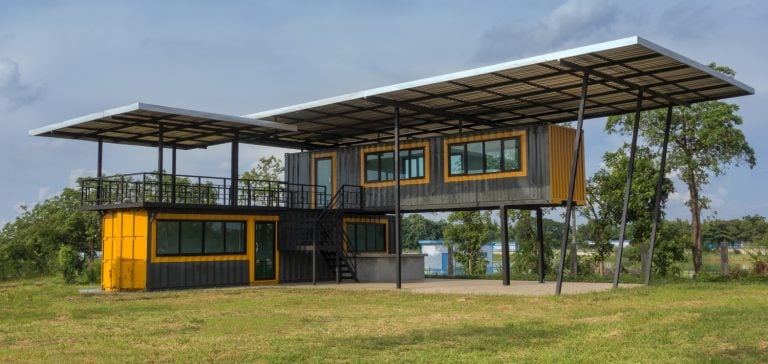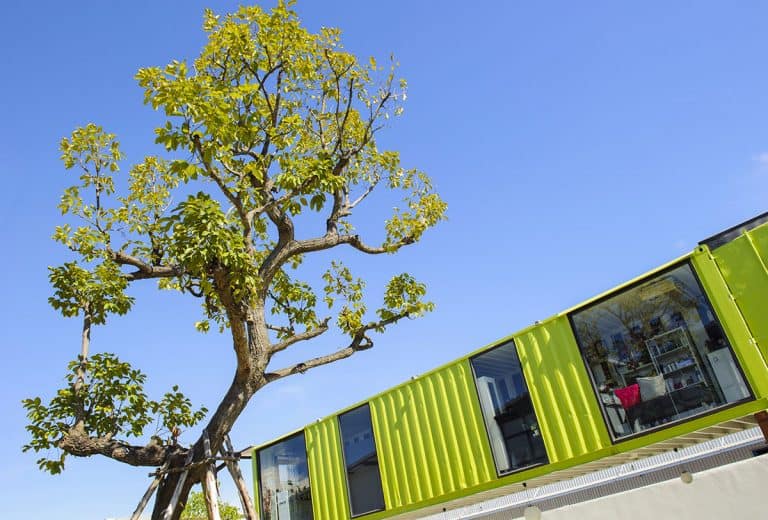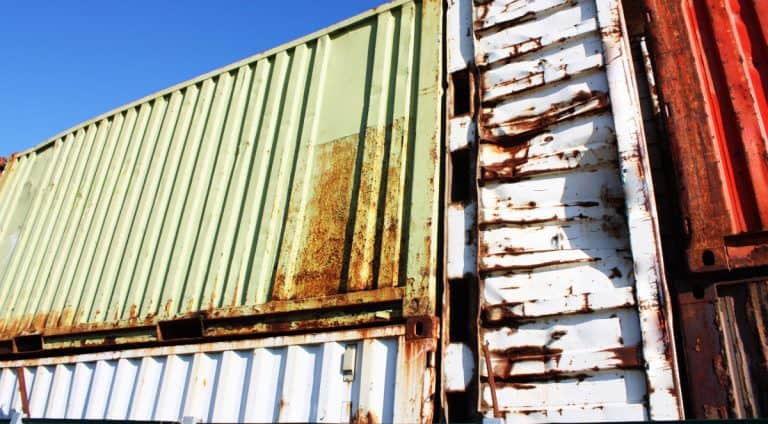Container Home vs. Log Cabin
Are you looking to build your own house or perhaps a pleasant little home away from home? And perhaps wondering if you should build a container home or a log cabin, as they both seem appealing in their own ways?
The main difference between container homes and log cabins is costs, as container homes are generally much cheaper to build. Moreover, they are easier to build and require less maintenance, whereas log cabins allow a little more creativity. Log cabins make a cozier impression, while container homes offer a more modern design.
In this article, we will go into detailes about the above-mentioned pros and cons of each. Then we will consider their many commonalities.
Cost to build
At the low end, it is possible to build a small DIY container home for as little as $10.000 or less. That will be a livable, but very basic home with no bells and whistles.
A 2,000 square foot mid-range container home will require approximately 6 used 40-foot containers at a price of around $2,200 each plus delivery. That alone will run you about $14,500. Add to that about $50,000 for heating, cooling, roofing, painting, etc. for a total of $65,000 for your affordable container home.
A custom-built container home, made from new factory-modified containers will cost upwards of $175,000. Which is a lot of money but still much less than the $250,000 that it costs to build an average house.
In comparison, a small 200 square foot log cabin kit will cost around $20,000. Add to that at least $5,000 for essential utilities, and you should expect to pay at least $25,000 for the most basic cabin.
A larger cabin built by professionals will run you about $125 to $175 per square foot or $250,000 to $350,000 for a 2,000 square foot turn-key home.
Since a significant part of the cost of container homes and log cabins are materials, you may be able to save a lot of money by sourcing it for free or cheap. So if you have access to cheap logs or shipping containers, that can make a big difference. Doing most of the labor yourself will lower the price, too.
Ease of Build
Container homes are easy to build in the sense that they are essentially like LEGO. Of course, there is a lot more to it than adding two or more containers on top of each other or next to each other, but where else do you get four walls and a roof without having to do any construction at all? Container homes are also quite easy to insulate, as long as one makes sure to use a vapor barrier.
Log cabins are available in construction kits, which saves you time and money, but they still take much more work to build. Wiring a log cabin can also be challenging. While container homes will usually have an insulated space between the inner and outer wall, where cables can be drawn, this is not the case for most log cabins. It certainly can be done, but it requires more work and creativity.
Creativity
When building container homes, you are somewhat limited by the boxy container shapes. Cutting them up to do something creative may well compromise its structural integrity. Of course, anything is possible, but it isn’t easy to do without expert advice and possibly significant expenses.
Log homes are much less limited as they are made from wood. You will still need to ensure a solid structure, but wood is very flexible and can be used in many different ways. Making it easier to follow your creative mind, as well as adding extensions without too much effort.
Maintenance
Container homes require very little maintenance. Rust is the primary issue. While the steel used in making shipping containers is very corrosion-resistant, it doesn’t last forever, and owners should make sure to maintain the paint to protect against corrosion on dented or scratched areas. It’s important to take special care of the roof where water may gather and accelerate the oxidation process.
Log cabins, on the other hand, require more maintenance than one might initially expect. They are also susceptible to pest infestations, such as termites and carpenter bees. As a biological material, wood also needs protection against the elements to keep it from rotting away. It should be painted or stained every few years to protect against moisture buildup.
The upside of log homes is that they can be easier repaired without the need for an experienced welder.
Impression
Container homes usually have a very modern look. The clean lines and steel material gives off a somewhat cold but stylish look.
Log homes have a much “warmer”, or cozy, look. They remind us of the good old days, sort of like The Lille House on the Prairie.
Of course, you can make a container home look cozy and a log home modern, but generally they each appeal to different aesthetic preferences.
What Do They Have in Common?
While container homes and log cabins are made from very different materials, they do have several things in common.
Mold and Humidity Issues
Both home types require a level of awareness in regards to the negative consequences of high humidity.
Wood will rot and mold quicky if it gets wet. This is a constant threat to any wooden building and should be taken seriously.
Container homes do not rot, but the steel construction cannot breathe, and metal easily functions as a thermal bridge accumulating condensation. Meaning you may experience a buildup of moisture, which can cause an unpleasant environment (especially in hot locations). It can also cause mold in your furniture and other products.
The solution is to make sure there are adequate insulation and ventilation. For container homes, it is essential to use a moisture barrier to protect the insulation. Also, watch out for mold behind furniture that is placed against an outside wall.
Hard(er) to Sell
Both homes are somewhat unusual structures, which makes them harder to sell. While you perhaps find alternative homes appealing, many prefer more traditional houses. This may reflect their sales value if you decide to move one day.
Insurance is Hard to Get
Like most other buildings made from untraditional materials, container homes can be very hard to insure. In theory, they should be insured easily and at a low cost. This is because shipping containers are categorized as Intermodal Steel Building Units (ISBU), which “comes with outstanding safety and fire ratings”.
However, many container home owners report that they have had to do a lot of legwork to get homeowners insurance. While it is not impossible, you will have to make your case to the insurance agent. Being able to prove that it is built to code (with documentation from an electrician etc.) will help your case a lot.
Another issue with getting insurance is liability protecion. The rigidity of metal structures such as shipping containers, while not very flammable, makes it difficult to escape a fire. Make sure to add emergency exits for your own safety and to get affordable insurance.
Log homes can also be hard to insure. This is because they are difficult to value. Estimating the replacement cost requires more work for the insurance company compared to standard homes, which means that not all companies are willing to offer homeowners coverage.
That being said, there are also agencies that are specialized in log home insurance and happy to have you as a customer. But expect to pay more than you would pay for a traditional home of similar size and condition.
A primary factor that determines the price of insuring any home is its price. Since log homes cost more to replace than container homes, the base insurance cost will also, generally, be higher.
Zoning, Codes, and Permits
Both log cabins and container homes are a little out of the ordinary, which can sometimes be an issue when applying for building permits.
Zoning regulations are largely up to each municipality and will vary a great deal depending on location. Building codes are set by each state but they are generally very similar.
As long as you stay up to code and build in the right zone, there should not be big issues with either building type. The issue arrives when applying for a permit.
While your planned construction may be entirely up to code, you may run into issues when getting your zoning application approved. Especially since zoning regulations are often very open to interpretation.
Depending on the county, it may be easier to get one type of building approved over another. A few places have very lax rules and will be a lot more welcoming to your building plans.






